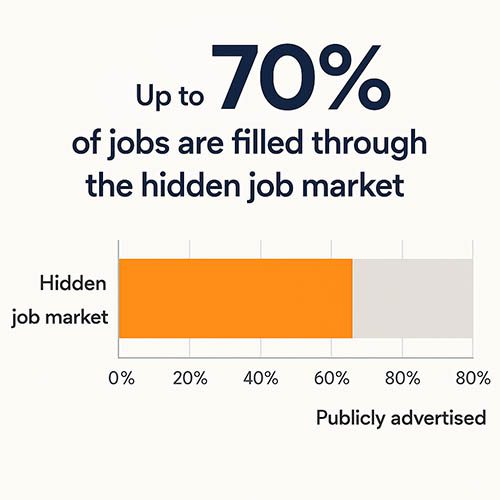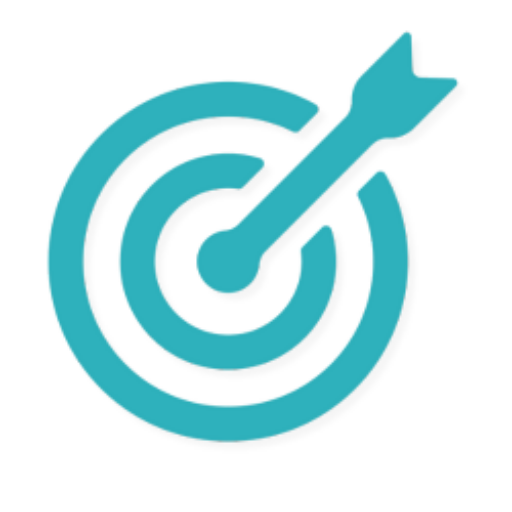I Landed My Dream Job Without Applying: 5 Real Stories of Hidden Job Market Success
You’ve polished your resume to perfection. You’ve written customized cover letters until your fingers ached. You’ve submitted dozens—maybe hundreds—of online applications.
And yet, silence.
If this feels painfully familiar, you’re not alone. But what if I told you that the most successful job seekers aren’t applying for positions at all?
As we’ve shared in our guide to the hidden job market, up to 70% of all jobs are filled without ever being publicly advertised. That’s right—the vast majority of opportunities never make it to job boards or company career pages.
Instead, they’re filled through a mysterious ecosystem of referrals, networking, and direct outreach. This hidden landscape is where the real action happens, while most job seekers waste time competing for the small fraction of positions that are publicly posted.
Today, we’re going beyond theory and statistics to show you real-world examples of people who successfully navigated the hidden job market to land their dream jobs—often in entirely new industries and without submitting a single application.
These aren’t hypothetical scenarios—they’re documented success stories from professionals who discovered that the traditional “apply and pray” approach isn’t the only way (or even the best way) to find meaningful work.
Let’s dive into their journeys and extract the specific tactics you can implement in your own job search.

Success Story #1: The Theater Professional Who Landed at Adobe
After spending years working in theater and earning a master’s degree in stage management, Johnson was ready for a change. At 30 years old, she was married and wanted more stability than the theater world could offer—better pay, regular hours, and the ability to put down roots.
But when she tried the traditional application approach, sending her resume and cover letters to companies throughout Seattle, she hit a wall. Hiring managers showed little interest in her theater background, despite the transferable project management skills she had developed.
The turning point came when Johnson leveraged a personal connection.
Her husband was working as a temp at Adobe Systems, which gave Johnson an introduction to a recruiter there. Instead of simply submitting an application, she pursued a conversation that led to a temp position as a project manager for a marketing program.
The temporary role soon converted to a contract position, and eventually to a permanent role. Later, her performance at Adobe led another software company to recruit her for an even more senior project management position.
Johnson credits her success entirely to networking: “Through both of my careers, I have landed all my jobs through contacts with other people. Through my life, I think I have gotten only one or two interviews from a resume sent out cold.” [Source: Remote-First Coaching]
Her experience demonstrates the power of what we call the “network effect resume“—optimizing your job search materials and approach for referrals rather than just applications.
Interview Guys Tip: Even a second-degree connection (like a spouse’s employer) can open doors. Instead of focusing solely on your own direct network, create a list of everyone you know and the companies they’re connected to. You might discover unexpected pathways to your target organizations.
Success Story #2: The Career Changer Who Found Her “True Calling”
When Teresa Goertz moved from Vancouver to Seattle, she faced multiple challenges. Not only was she in a new city where she knew virtually no one (except her soon-to-be husband), but she was also looking to leave her 13-year career in financial services to pursue technical writing—her “true calling.”
The obstacles were significant:
- No professional writing experience
- Limited technical background
- Few local connections
- Attempting a major career change
Rather than flooding the market with applications, Goertz took a strategic approach to building her skills and network simultaneously.
She enrolled in a technical writing certification program at Bellevue College, which served two crucial purposes: it gave her the credentials she needed and put her in direct contact with people in her target industry.
This strategic move to leverage an educational environment as a networking opportunity completely transformed her job search. Instead of trying to convince employers to take a chance on a career-changer with no relevant experience, she was able to build relationships with professionals who could vouch for her abilities and connect her to opportunities. [Source: Remote-First Coaching]
Interview Guys Tip: Educational programs aren’t just about gaining skills—they’re rich networking environments with built-in connections to your target industry. Even a short certificate program can place you in the midst of exactly the right people who can help facilitate your career transition.
Success Story #3: The Cold Outreach Champion Who Joined Airbnb
Raghav Haran’s approach to landing a job at Airbnb demonstrates that you don’t need insider connections to tap into the hidden job market—you can create your own opportunity through strategic outreach.
When Haran first moved to New York, he knew absolutely no one. Yet within 12 months, he had secured referrals for interviews at Google, Microsoft, Twitter, and ultimately landed a position at Airbnb—all without submitting traditional applications.
His approach was methodical:
- Identify an influencer at the target company—specifically someone who would have input on hiring decisions for his desired role.
- Send a personalized cold email with the subject line “Quick Question” (which his testing showed generated a 66.7% response rate from executives).
- Request a brief meeting and during the conversation, ask this critical question: “What is the biggest challenge your team is facing right now?”
- Create a detailed solution to the specific problem identified in the meeting, essentially creating a work sample tailored to the company’s exact needs.
- Follow up with the proposed solution, positioning it as a helpful resource rather than a job application.
This approach often led to the influencer sharing his work with the team, which naturally evolved into discussions about employment opportunities—without Haran ever having to explicitly ask for a job.
As he explains it: “Rather than submitting 50 resumes and praying, or going to hundreds of meet-ups, I used a laser-focused approach to networking.” [Source: Fast Company]
This strategy is particularly powerful because it demonstrates your value to the company before they’ve even hired you. By identifying and solving a real problem, you transform yourself from an unknown quantity into a proven asset.
Interview Guys Tip: Before reaching out to a company, do thorough research on their current challenges or initiatives. Check their recent press releases, blog posts, and executive interviews to identify issues you can address. When you reach out, you’ll be able to ask more informed questions and offer more relevant solutions.
Success Story #4: The Finance Professional Who Leveraged an Unexpected Chain of Referrals
One finance professional looking to lead a Financial Planning and Analysis group in the media sector took an approach that many job seekers overlook: she told absolutely everyone in her network about her job search.
Rather than quietly applying to positions or selectively reaching out to close connections in her target industry, she sent an email to her entire network explaining her career goals and the specific position she was seeking.
The results were surprising. As career coach Rob Hellmann reports, “the people she least expected to help her responded with the best leads.”
In one particularly remarkable case, her neighbor’s husband’s brother’s wife connected her with the CFO of a global media company, which led directly to an interview.
This unlikely chain of connections—four degrees separated from her original contact—would never have materialized if she had limited her networking to the obvious industry insiders or close professional contacts. [Source: Hellmann Consulting]
The key insight here is that you never know who in your extended network might have a valuable connection. By casting a wide net and being specific about what you’re looking for, you increase the chances of activating unexpected connections that can lead to opportunities you would never find through traditional applications.
This approach aligns perfectly with our advice on how to turn cold connections into job referrals. Sometimes, the most valuable referrals come from the most unexpected sources.
Interview Guys Tip: When reaching out to your network, make sure to “bcc” all recipients to protect their privacy. Be specific about the type of role you’re seeking and make it clear that you’re not asking them for a job directly—just a brief conversation or potential connection. This lowers the barrier to helping you.
Success Story #5: The Restaurant Manager Who Found Her Tech Job Through Social Media
Alyssa Gioscia was working for a restaurant group and ready for a change when she discovered the power of social media networking.
Rather than scrolling through job boards, she began following employees from companies she admired on various social platforms. She paid particular attention to what they were posting about their work, company culture, and job openings.
“Before I started with CareerArc, I was working for a restaurant group and was ready for a change,” explains Gioscia, now Director of Enterprise Development at CareerArc. “I found my current role through a LinkedIn post from a current employee sharing an opening on the sales team.”
What made this approach so effective was that she didn’t just passively observe—she actively engaged with content, commenting on posts and building relationships before ever expressing interest in employment.
By the time she reached out about the position, she had already established a presence in the employee’s social media world, making the transition from follower to candidate much more natural. [Source: CareerArc]
This strategy has become increasingly effective in recent years, with many companies now encouraging employees to share job openings on their personal social networks. By following and engaging with employees at your target companies, you can often learn about opportunities before they’re widely advertised—or even access roles that are primarily filled through referrals.
Our guide to secret LinkedIn search strings can help you identify and connect with exactly the right people at your target companies.
Interview Guys Tip: Don’t just follow company pages on social media—follow actual employees, especially those in departments where you’d like to work. Engage genuinely with their professional content for several weeks before making any job-related inquiries. This builds familiarity and goodwill that makes them more likely to refer you when an opportunity arises.
The Common Threads: What These Success Stories Teach Us
While each of these stories features a unique approach to the hidden job market, several powerful patterns emerge:
1. Value First, Job Second
None of these successful job seekers began by asking for employment. They focused first on building relationships, delivering value, or demonstrating skills—making the job conversation a natural next step rather than a cold request.
2. Specificity Matters
Each person was clear about exactly what they wanted. Whether it was a particular role, industry, or company, they communicated specific goals that made it easier for others to help them.
3. Unexpected Connections Often Yield the Best Results
In multiple cases, the successful connection came from a surprising source—not the obvious industry insider or close professional contact, but someone further removed who happened to have the right link.
4. Personal Introductions Trump Cold Applications
Even when formal applications were eventually submitted, they came after a personal connection had been established, essentially transforming a cold application into a warm referral.
5. Persistence and Creativity Open Doors
All of these job seekers went beyond the standard approach. They were willing to try unconventional tactics, whether that meant solving a company’s problem before being hired or leveraging social media to build relationships with current employees.
How to Create Your Own Hidden Job Market Success Story
Ready to write your own success story? Here’s a step-by-step action plan based on the lessons from these real-world examples:
Step 1: Define Your Target Precisely
Before you start networking or reaching out, get crystal clear on exactly what you want:
- Which industries and companies interest you?
- What specific roles would leverage your strengths?
- What environments would allow you to thrive?
The more specific you can be, the easier it will be for your network to help you—and the more focused your efforts will be.
Step 2: Map Your Existing Network
Create a comprehensive list of your connections, including:
- Former colleagues and classmates
- Friends and family
- Alumni from your school
- Members of professional organizations
- Social media connections
Remember to think beyond first-degree connections. As our finance professional discovered, sometimes it’s the friend-of-a-friend-of-a-friend who provides the crucial introduction.
Step 3: Develop Your Value Proposition
Before asking for help or referrals, clarify what you bring to the table:
- What specific problems can you solve?
- What unique skills or perspectives do you offer?
- How have you added value in previous roles?
Having a clear, compelling narrative about your value makes it easier for others to advocate for you.
Step 4: Implement Multiple Hidden Market Strategies
Based on our success stories, choose at least three of these approaches:
- The Warm Introduction: Identify second-degree connections at target companies and ask for introductions.
- The Education Connection: Take courses or certifications that put you in contact with professionals in your target field.
- The Problem Solver: Research challenges at your target companies and develop potential solutions to share.
- The Network Broadcaster: Send a specific, well-crafted message to your entire network about what you’re looking for.
- The Social Media Strategist: Follow and meaningfully engage with employees at target companies.
Step 5: Track and Learn from Results
Keep detailed records of your outreach efforts:
- Who you contacted
- What approach you used
- The response received
- Next steps
Use this data to refine your approach, focusing more energy on the strategies that yield the best results for your specific situation.
Conclusion: The Hidden Path to Your Dream Job
The traditional job application process feels safe and straightforward—see posting, submit resume, wait for response—but its very transparency is what makes it so competitive and often ineffective.
The hidden job market, by contrast, might seem mysterious and inaccessible, but as these five success stories demonstrate, it’s actually where the real opportunities lie. By shifting your focus from applications to connections, from resumes to relationships, and from competing to contributing, you dramatically increase your chances of not just finding a job, but finding the right job.
As Johnson, our theater-to-tech professional, put it: “It’s not what you know, it’s who you know. The ‘what’ really counts when you get in the door, but the ‘who’ is the most important aspect of getting it opened.”
That door to your dream job is waiting. And now you have the keys.

BY THE INTERVIEW GUYS (JEFF GILLIS & MIKE SIMPSON)
Mike Simpson: The authoritative voice on job interviews and careers, providing practical advice to job seekers around the world for over 12 years.
Jeff Gillis: The technical expert behind The Interview Guys, developing innovative tools and conducting deep research on hiring trends and the job market as a whole.






